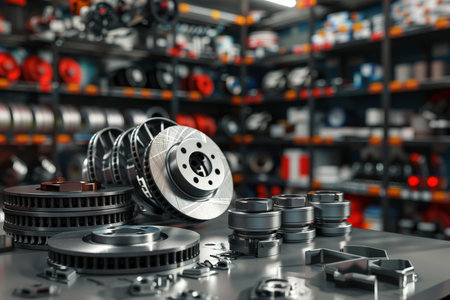Introduction to Car Fluids and Why They Matter
When it comes to keeping your vehicle in top condition for the unpredictable British weather and ever-changing road conditions, understanding your car’s vital fluids is essential. Whether you’re a weekend DIY enthusiast or simply want to avoid unnecessary trips to the garage, knowing how to check, top up, and replace these fluids can help maintain your car’s performance and safety on UK roads. Your car relies on a range of fluids—including engine oil, coolant (antifreeze), brake fluid, power steering fluid, transmission fluid, and windscreen washer fluid—to run smoothly and reliably. Each of these plays a crucial role: engine oil lubricates moving parts to prevent wear; coolant keeps the engine from overheating during those rare summer heatwaves or protects it from freezing on frosty mornings; brake fluid ensures responsive stopping power in all weather; power steering fluid helps you manoeuvre easily around tight city streets; transmission fluid allows for smooth gear changes; and washer fluid keeps your windscreen clear through rain, sleet, or mud. Regularly checking and maintaining these fluids not only extends the lifespan of your car but also ensures safer driving—something every motorist values when navigating the UK’s busy roads and motorways.
2. Essential Tools and Safety Tips
Before you start topping up or replacing vital fluids in your car, its important to have the right tools on hand and to follow key safety guidelines. Doing so ensures not only your own safety, but also protects the environment, in line with UK laws.
Basic Tools You’ll Need
| Tool | Description |
|---|---|
| Funnel | Helps pour fluids cleanly without spills. |
| Measuring Jug | Ensures accurate fluid quantities. |
| Gloves | Protects your skin from chemicals. |
| Rags or Paper Towels | Cleans up drips and spills quickly. |
| Drain Pan | Catches old fluids during replacement. |
| Screwdrivers/Wrench Set | For loosening reservoir caps and drain plugs. |
| Torch/Lamp | Makes it easier to see under the bonnet, especially in low light. |
| Jack and Axle Stands (if needed) | Lifts the vehicle safely for better access underneath. |
Safe Fluid Handling: Top Tips
- Wear protective gloves and eye protection: Many automotive fluids are corrosive or toxic. Always use suitable PPE when handling them.
- Avoid open flames or sparks: Fluids like petrol are highly flammable—never smoke near your vehicle during maintenance.
- Work in a well-ventilated area: Some fumes can be harmful; keeping fresh air circulating is crucial.
- Tidy up immediately: Clean any spills straight away to avoid slips or paintwork damage.
- Keep children and pets away: Store all fluids securely after use, well out of reach of little hands or paws.
Disposal Advice: Stay Green, Stay Legal
The UK has strict environmental regulations for disposing of car fluids. Never pour used oil, coolant, or brake fluid down drains or onto the ground. Instead:
- Take used fluids to your local recycling centre or council tip: Most facilities have designated bins for engine oil, coolant, and other automotive liquids. Check your local councils website for details on accepted materials and opening times.
- Use proper containers: Transport used fluids in sealed, labelled containers to prevent leaks during transit.
- Avoid mixing different types of fluids: Mixing can make recycling more difficult and may even be hazardous.
If in doubt, ask!
If you’re unsure about how to handle or dispose of a particular fluid, consult your vehicle handbook or speak with staff at your local recycling centre—they’ll be happy to advise on best practices for safe and legal disposal in the UK.

3. How to Check and Top Up Engine Oil
Step-by-Step Guide to Checking Your Engine Oil Level
Keeping your engine oil at the correct level is essential for protecting your car’s engine and ensuring smooth running, especially with the unpredictable UK weather. Follow these steps for a quick and effective oil check:
Step 1: Park on a Level Surface
For an accurate reading, always park your car on flat ground and wait at least five minutes after switching off the engine. This allows the oil to settle back into the sump.
Step 2: Locate and Clean the Dipstick
Open your car’s bonnet and look for the dipstick – it usually has a brightly coloured handle (often yellow or orange). Pull it out, wipe it clean with a lint-free cloth or kitchen roll, then reinsert fully.
Step 3: Check the Oil Level
Remove the dipstick again and look at the end. The oil should be between the minimum and maximum marks. If it’s close to or below minimum, it’s time to top up.
Choosing the Right Oil Grade for UK Conditions
The UK climate ranges from chilly winters to mild summers, so selecting an oil that suits our weather is crucial. Most modern cars require a multigrade oil like 5W-30 or 5W-40, which flows well in low temperatures yet provides protection when hot. Always check your owner’s manual or ask a reputable UK motor factors shop for advice specific to your make and model.
How to Safely Top Up Your Engine Oil
Step 1: Remove the Filler Cap
Find the oil filler cap (usually marked with an oil can symbol), unscrew it, and set aside.
Step 2: Add Oil Gradually
Using a funnel, pour in small amounts of oil at a time—about 100–200ml per go—to avoid overfilling. Give it a minute to settle before rechecking with the dipstick.
Step 3: Repeat as Needed
Add more oil if necessary, always keeping within the minimum and maximum markers. Wipe up any spills promptly to prevent burning smells when you next drive.
Top Tip:
If you’re unsure about which oil to use or how much to add, most local garages or parts shops across the UK are happy to offer advice—don’t be afraid to ask!
4. Checking and Refilling Coolant
Keeping your coolant at the correct level and mixture is crucial for your car’s health, especially with the unpredictable UK weather. Coolant not only prevents your engine from overheating but also protects against freezing during cold snaps. Here’s how to check and top up or replace coolant safely:
Step-by-Step Instructions for Checking Coolant Levels
- Park Safely: Always ensure your vehicle is parked on a level surface and the engine is completely cool before opening the bonnet.
- Locate the Reservoir: Find the coolant reservoir—usually a translucent plastic tank near the radiator, clearly marked with ‘MIN’ and ‘MAX’ lines.
- Check Level: Visually inspect the fluid level. It should be between these two lines. Never open the cap when the engine is hot to avoid burns from steam or splashes.
Selecting the Right Coolant Mixture for UK Conditions
In the UK, you need an antifreeze mix that handles both chilly winters and mild summers. Most modern cars use long-life OAT (Organic Acid Technology) coolant, but always check your owner’s manual or consult a trusted local supplier for specifications.
| Season | Recommended Mix Ratio (Coolant:Water) | Purpose |
|---|---|---|
| Winter (Below 0°C) | 50:50 | Prevents freezing and corrosion |
| Summer (Above 0°C) | 40:60 or as specified | Keeps engine from overheating |
Topping Up Your Coolant
- If low, slowly remove the reservoir cap (only when cool).
- Add pre-mixed coolant or mix concentrated coolant with deionised water according to your car’s requirements.
- Avoid overfilling above the ‘MAX’ line.
- Refit the cap securely and wipe away any spills to prevent corrosion.
Replacing Old Coolant (DIY Guide)
- Drain: Place a suitable container under the radiator drain plug. Open it carefully to let old coolant flow out completely.
- Flush: You can flush with clean water if required (check your manual), then close the drain plug tightly.
- Refill: Pour in fresh coolant mixture up to ‘MAX’. Bleed any air by running the engine briefly with the heater on full until bubbles stop appearing in the reservoir.
- Dispose Responsibly: Take old coolant to your local recycling centre—never pour it down drains as it’s harmful to wildlife.
Handy Tip for UK Drivers:
Always keep some ready-mixed coolant in your boot during winter journeys—rapid temperature drops are not uncommon in Britain, especially on early morning commutes or trips through rural areas.
5. Refilling Washer Fluid and Protecting against UK Weather
Keeping your windscreen washer fluid topped up is essential for safe driving on British roads, where unpredictable weather and road grime are common. Here’s a simple guide to checking and refilling your washer fluid, along with tips tailored for the UK climate.
How to Check and Top Up Washer Fluid
Begin by opening your car’s bonnet and locating the washer fluid reservoir—usually marked with a windscreen icon on the cap. Check the fluid level against the markings on the side of the reservoir or simply open the cap and look inside. If the level is low, top up using a suitable washer fluid. Avoid using plain water as it can freeze in winter or promote algae growth in summer.
Choosing the Right Mixture: Winter vs Summer
In the UK, winter demands a washer fluid with antifreeze properties to prevent freezing and ensure effective cleaning in chilly conditions. Opt for a concentrated screenwash that protects down to at least -10°C; dilute it according to manufacturer instructions. For summer, use a standard premixed screenwash or concentrate diluted with water, which helps remove bugs, dust, and pollen without leaving streaks.
UK-Specific Tips for Clear Windscreens
The combination of frequent rain, road salt, and mud means UK drivers should check their washer fluid regularly—especially before long journeys or after spells of bad weather. Always keep a spare bottle of screenwash in your boot during winter months. Remember, it’s illegal to drive with an empty washer reservoir in the UK if it limits your vision. Regularly clean your wiper blades to prevent smearing and replace them annually for best results.
Inspecting and Topping Up Brake and Clutch Fluids
Maintaining proper levels of brake and clutch fluids is essential for your car’s safety and overall performance, especially on UK roads where variable weather can add extra strain to your vehicle’s systems. Both fluids play a critical role in ensuring responsive braking and smooth gear changes. Here’s how to check, top up, and stay compliant with UK regulations.
Signs Your Brake or Clutch Fluid May Be Low
Before you even pop the bonnet, it’s important to recognise signs that your brake or clutch fluid may need attention. Common symptoms include:
- A spongy or soft brake pedal feel
- Increased stopping distance or reduced braking efficiency
- Difficulty changing gears (for manual cars)
- Warning lights illuminated on the dashboard
- Visible fluid leaks under the car near the wheels or pedals
Steps for Safe Inspection and Topping Up
- Park Safely: Ensure your car is parked on a flat surface with the engine off. Engage the handbrake for added safety.
- Locate the Reservoirs: Open the bonnet and locate the brake and clutch fluid reservoirs. Most UK cars have clearly marked caps; check your owner’s manual if unsure.
- Check Levels: Inspect the side of each reservoir – there will be ‘MIN’ and ‘MAX’ markers. The fluid should sit between these lines. If it’s below ‘MIN’, topping up is needed.
- Select the Right Fluid: Only use the type of brake or clutch fluid recommended by your manufacturer – commonly DOT 4 or DOT 5.1 for most UK vehicles.
- Add Fluid Carefully: Clean around the cap before opening to avoid contamination. Pour fluid slowly up to the ‘MAX’ line, taking care not to overfill.
- Secure Caps: Replace the caps tightly and wipe away any spills immediately, as brake fluid can damage paintwork.
Important Safety Tips
- Avoid mixing different types of brake/clutch fluid.
- If you notice dark, dirty, or milky fluid, it may be time for a full system flush rather than just a top-up – seek professional advice if unsure.
UK MOT Test Considerations
The annual MOT test in the UK includes checks on both brake and clutch systems. Low or contaminated fluids can result in an MOT failure due to safety concerns. Regularly inspecting and maintaining correct levels will not only keep you safe but also help you pass your MOT without unnecessary hassle or expense.
DIY Maintenance Makes a Difference
Topping up brake and clutch fluids is a straightforward job most motorists can tackle at home with minimal tools. Staying proactive helps ensure reliable performance on Britain’s busy roads while supporting vehicle longevity. Always consult your owner’s handbook for model-specific guidance, and when in doubt, don’t hesitate to consult a qualified mechanic.
7. Proper Disposal and Environmental Responsibility
When carrying out DIY car maintenance in the UK, its essential to handle used or excess fluids—like engine oil, coolant, brake fluid, and transmission fluid—with care. Improper disposal can harm the environment and lead to hefty fines under UK regulations.
Why Responsible Disposal Matters
Automotive fluids contain substances that are hazardous to waterways, soil, and wildlife. Pouring them down drains, onto the ground, or into household bins is illegal and environmentally damaging. Following best practices ensures you stay compliant with UK law while protecting the planet.
How to Safely Dispose of Car Fluids
- Collect Fluids Carefully: Use a suitable container for each type of fluid. Avoid mixing different fluids as this complicates recycling and disposal.
- Store Securely: Keep containers sealed and clearly labelled until you can take them to a disposal site. Store them away from children and pets.
- Use Designated Facilities: Most local council recycling centres (also known as Household Waste Recycling Centres) accept waste engine oil, antifreeze, brake fluid, and other automotive liquids. Check your councils website for locations and accepted materials.
UK Regulations You Should Know
- The Environmental Protection Act 1990 makes it illegal to dispose of hazardous fluids irresponsibly.
- Some garages or auto parts retailers may also offer take-back schemes for used oil or batteries—ask locally if unsure.
Quick Tips for Eco-Friendly Practice
- Never pour car fluids down household drains or stormwater systems.
- If a spill occurs, clean it up immediately using absorbent materials like sand or cat litter—dispose of these as hazardous waste too.
By taking these steps, you’ll not only keep your car running smoothly but also do your part for the UK’s environment and community safety. Always check local guidelines if in doubt, and make responsible disposal an integral part of your DIY car maintenance routine.


